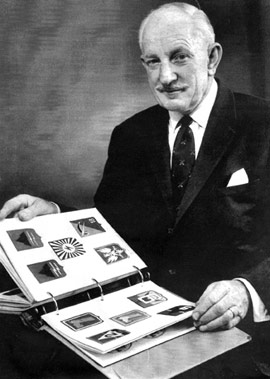
 John Waring, the founder of our Society, began his military career when he joined the Territorial Army in London in 1938 at the age of 25. Commissioned into the Durham Light Infantry a year later, he was posted to the regiment’s recently-formed 16th Battalion in 1941, subsequently serving in North Africa and Italy where he commanded C Company during the Salerno Landings in September 1943. Invalided from his Battalion after being wounded in action he subsequently served with a unit of the Free Polish forces.
John Waring, the founder of our Society, began his military career when he joined the Territorial Army in London in 1938 at the age of 25. Commissioned into the Durham Light Infantry a year later, he was posted to the regiment’s recently-formed 16th Battalion in 1941, subsequently serving in North Africa and Italy where he commanded C Company during the Salerno Landings in September 1943. Invalided from his Battalion after being wounded in action he subsequently served with a unit of the Free Polish forces.
After the war Captain Waring served on intelligence duties in Aden, at the War Office and with HQ Far East Land Forces. During his service in Aden John Waring collected plant specimens for Kew Gardens and published a work on the flora of Aden, for which he was awarded a Fellowship of the Royal Geographical Society. Promoted to Major, John served in the South Arabian Protectorate, followed by further spells at the War Office and in the Far East before his final appointment with the Bristol University Officer Training Corps from which he retired in 1968.
Major Waring and his family settled in Norfolk after leaving the army where he worked for Her Majesty’s Stationery Office, pursued his interest in botany, became a District Councillor and was active in several military associations. John Waring died in Norfolk in August 1977 aged 64.
During his military service John had become interested in the large numbers of cloth badges introduced during the war for wear on British Army uniforms and had begun to collect and study them. This interest led to a meeting in December 1950 to discuss the formation of a Society to encourage the study and recording of cloth badges which became the Military Heraldry Society. The first issue of the Journal, then simply known as The Bulletin appeared in April 1951, a name it bore until issue 64 in January 1967 when it became The Formation Sign.
John Waring built up an extensive personal collection of cloth badges worn by the armed forces of the world. After his death this was housed in the museum of the Royal Corps of Transport but was subsequently passed to the National Army Museum in London where it remains, although sadly not on public display.
If you feel that the Society is for you and would like to join, please click here
If you would like more information before joining please email militaryheraldrysociety@gmail.com